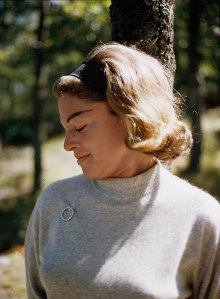Though she cared deeply for her husband, the marriage didn’t last a year. “He deserved more. He deserved somebody who thought he was absolutely everything. I left. I told him I needed something else,” she says. She confided to him that she longed to be with women. When Windsor moved to New York City in the early ’50s, the gay community was robust but underground. Sodomy was then outlawed in every state, and the police frequently raided gay bars downtown. It wasn’t easy for a relatively conservative person like Windsor to find other gay people. The first time she went to a gay bar, she got off a bus at Washington Square Park and asked a woman in a trench coat and pink oxfords if there were a bar “where only women go.”
“I sat at that damn bar with one drink, and nobody would talk to me,” Windsor recalls. “I was way overdressed. I lasted about two hours, and went back uptown.” For a while she dated men, and eventually she found a crowd of gay men to be friends with. But lesbians were hard to come by. When she saw a lesbian couple dancing at a gay bar, she says, she thought, “I hope I have that when I’m old.”
“I Lied All The Time”
Once in New York City, Windsor faced a difficult economic reality of the ’50s: without a husband, she would have to support herself with a job in a male-dominated workplace. She began master’s studies in applied mathematics at New York University in 1955, learned to program computers and started working on the Atomic Energy Commission’s UNIVAC computer, which was installed at NYU. When the FBI called for an interview regarding her security clearance, she was sure the agency had discovered she was gay and that she would lose her job. She dressed “feminine” for the interview in crinolines and high heels, she recalled in her affidavit, but it turned out the investigators wanted to know about her sister’s friends in a union. On the strength of her work at NYU, Windsor went to work for IBM in 1958.
She first met Thea Spyer, a striking beauty with a sharp, analytical mind, at a restaurant in 1963. Spyer—who came from a wealthy family in Holland, spoke Dutch, played the violin beautifully and had been thrown out of Sarah Lawrence for kissing a woman—was playing the field. Later at a party, they danced all night, even after they’d put their coats on to leave, as their irritated dates looked on.
As the couple grew closer, Windsor was forced to keep the relationship quiet at work, which meant distancing herself from the IBM colleagues she loved. When she was single, she went out with them on weekends, “but once I was in love with somebody, I wasn’t going to go to the wine tasting alone, and I wasn’t going to bring [Thea], that’s for sure,” she says. “I lied all the time.” To explain why Spyer called her at work, she invented a relationship with Spyer’s “brother Willy”—who was actually a childhood doll that Windsor still keeps in her closet.

Courtesy Edith Windsor
Thea proposed to Edie with a diamond pin in 1967.
In 1967, Thea proposed to Edie with a diamond brooch, because an engagement ring would have been too risky. (Homosexuality wouldn’t be declassified as a mental illness in the Diagnostic and Statistical Manual of Mental Disorders until 1973.) Edie longed to confide in someone about her love. The night before a biannual conference for computer programmers on the West Coast—where members of the small community, who had gotten to know each other over the years, shared the news of their lives—the usually gregarious Edie felt silenced. “I [thought], you know, I’m sitting here not saying anything, and the most important thing in my life has happened,” she says. So she told the small group of people about Thea, and it turned out they were supportive.
Family life was just as hard to manage. Spyer’s family in New York disapproved, so the couple spent the first few Thanksgivings after they got engaged at Windsor’s sister’s house in Philadelphia. That ended, partly because her sister’s husband seemed to not want to spend time with a lesbian couple.
Changing Attitudes
In 1969, after a police raid at a Greenwich Village gay bar called the Stonewall Inn, the patrons, many of them drag queens, responded with a violent series of riots that began the gay-liberation movement. Suddenly, barriers that had separated factions within the community started to fall. Windsor, who like other members of her generation was unhappy to be associated with “queens,” changed her mind after Stonewall. “It was the beginning of seeing another hunk of us—they are human, they don’t have horns, and they just changed my life,” she says.
During the 1970s and ’80s, Windsor and Spyer lived a lot like any other upwardly mobile professional couple. Windsor worked at IBM, and Spyer built a robust practice as a psychologist. (Edie had to cancel two patients’ appointments the day Spyer died.) Spyer was a talented cook, and they hosted dinner parties for a glamorous circle of friends at their apartment in the city and at a modest beach house they had in Southampton. They were active in groups like the East End Gay Organization on Long Island, for which they hosted a yearly party over Memorial Day weekend.

